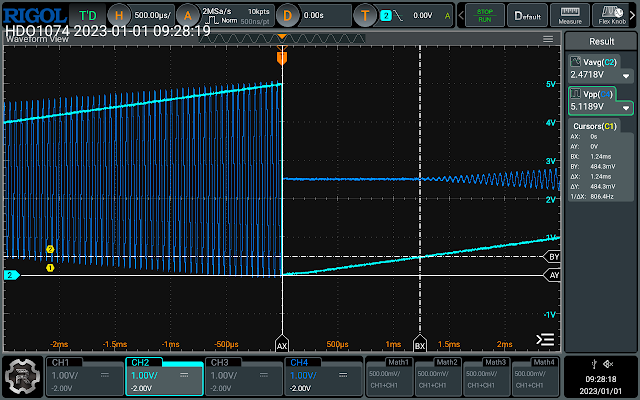Update 3/17/2023:
The +5V circuits do work well, but I have since decided that +15V single supply power for analog waveform generation and signal processing has several advantages. Among them are 20 years of research and development in LM3900 circuit designs. More updates in a blog post.
I am now working to build an integrated Model III synthesizer, an all-in-one unit that is semimodular, rather than a modular machine. To simplify all aspects of this synthesizer development, I have been adapting my various circuit designs to +5V only operation. Use of a single power supply voltage is quite enabling given modern high-performance rail-to-rail CMOS op amps. +5V power otherwise simplifies system design, in terms of decoupling, power tracks, and ground planes for PCBs. Because the overall wattage actually required is so small due to (mostly) CMOS IC implementation, the power input can be a garden variety +12V 1A power brick that is often used for USB disk drives. This allows voltage step-down and prefiltering for noise and hum through intermediate power regulators. Which then provide input for precision +5V CMOS LDO regulators that can be sprinkled around the system to keep individual sets of functions isolated via separate regulators, but otherwise all circuits have a common ground.
One design I repurposed along these lines was my Trimless VCA, as it already had a |5V| orientation from the beginning. This turned out to be super simple, and required even fewer components to implement than the original design which used a pair of LM4040AIZ-2.5 precision references but otherwise used ±15V power supplies and op amps. This new +5V Trimless VCA required only 14 parts, whereas the original required 24, including decoupling capacitors. Engineering notebook data, schematic and characterization data index is next:
The changes made to the original design mostly had to do with setting the transconductance core to use 0-5V, instead of ±2.5V. This was done by adding a +2.5V common mode voltage (see VZR discussion, below), via a buffered voltage reference: the same one used before, the LM4040AIZ-2.5. Any DC coupled input signal is expected to arrive with a +2.5 VZR. Alternatively, AC coupling could be used. A supplementary change though was changing the signal input attenuation to not limit as quickly, and this is discussed a few paragraphs hence. Removing the DC summer op amp that was used in the original design to provide a -2.5V level shift does leave the Control Voltage input unbuffered at a lower impedance. Since control signal normalization would be used in the synthesizer anyway, this change seemed innocuous. Otherwise the design retains all the features of the original:
- I/O range is 0-5V (signal input considered to be up to a ±2.5V signal offset at +2.5V).
- Control voltage range is 0-5V, with the same turn on voltage of about 484mV. Below this, the VCA is "off" and there is no measureable DC feedthrough. The "zero" output rests at an interoperable +2.5V (see notes on VZR, below) when the VCA is off, and is unaffected by signal path input.
- Above the turn on voltage, the VCA response is linear.
- Wideband audio signal response, far in excess of 20 kHz. Low-noise output, modest distortion.
- Zero deleterious responses to fast edge waveforms.
Use of a +5V unipolar power supply means that a common mode voltage needs to be used for DC coupling of signals intended to be bipolar. This is what I call Voltage Zero Reference (VZR), and used I that concept a lot for +15V only synthesizer circuit designs with the LM3900, noted at my other blog. For widest dynamic range on a +5V system, the best VZR is +2.5V, or Vdd/2.
+5V power though really is a strict limitation. The previous Trimless VCA was more forgiving in output amplitude before clipping because the op amp that performed differential to single ended conversion from the notionally ±2.5V transconductance core was powered on ±15V. In the adapted +5V only design, the input attenuator resistor (R1) had to be increased so as to prevent clipping at full-scale control voltage of +5V, given op amps that can meet the +5V and ground rails, but not beyond. For bench testing, and due to an incomplete 1% resistor collection, the R1 input resistor was modified for near-optimal distortion-free voltage output by sizing from the original 90.9kΩ 1% to ultimately 104.8kΩ. Accomplished by using a 49.9kΩ 1% resistor in series with a 54.9kΩ 1% resistor, which were 1% parts that I did happen to have on hand. This could become a 105kΩ 1% resistor. But I also like the split resistor configuration too. Because a front panel control could be devised to increase the signal drive progressively. Such a control would enable the VCA to have programmable overdrive distortion if desired.
Some exemplary scope fotos now follow.






Comments
Post a Comment